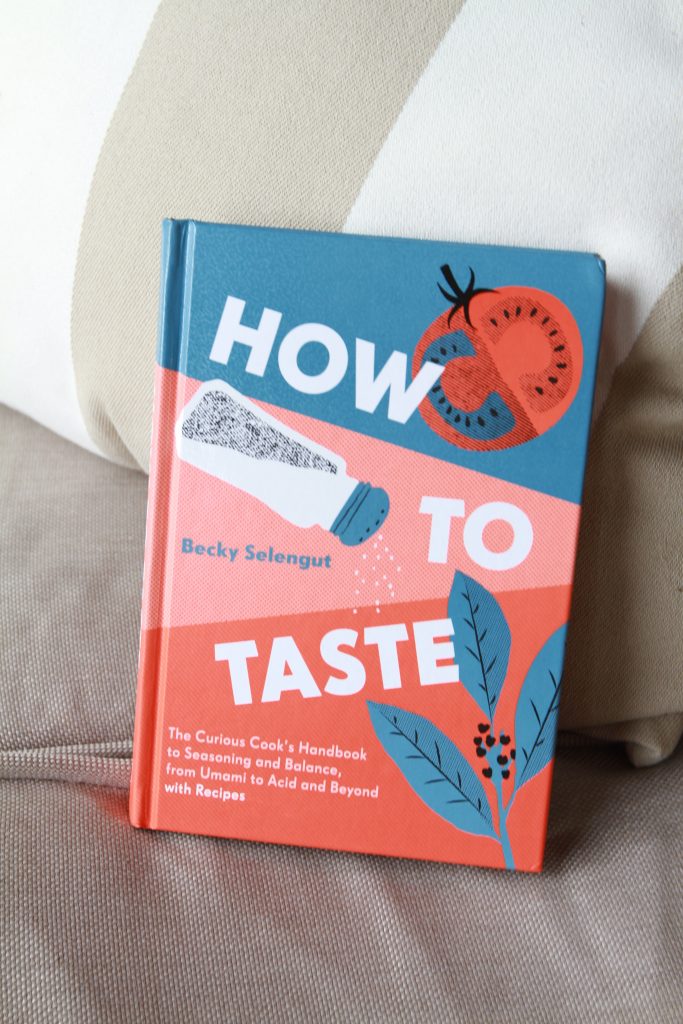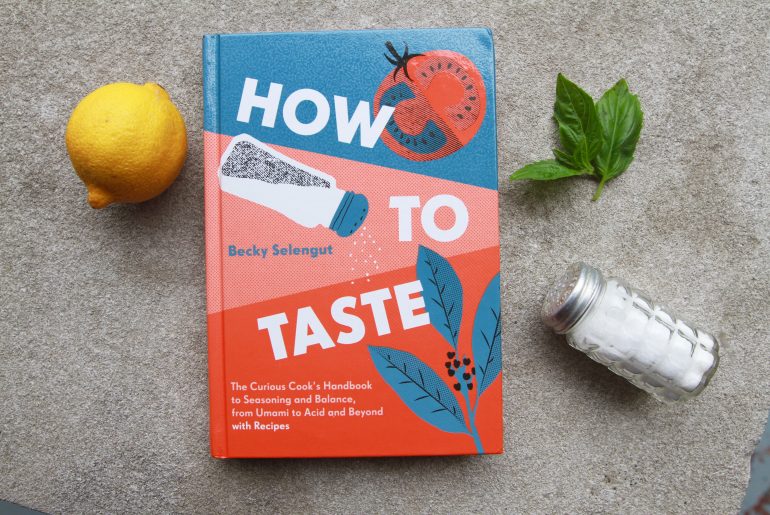Perhaps the best handbooks are the ones we didn’t know we needed. If you’ve ever wondered why your dinner turned into a disaster, or you think salt is the savior of all your culinary problems, Here to Taste ($17.99, 240 pages) is here to help.
Everyday, home cooks fiddle in the kitchen without really understanding why we do the things we do — some spices here, hotter temperatures there. But are these decisions really making our food the best it can be?
There’s a lot that goes into the underlying principles of flavorful food, and certainly most of us wouldn’t have time to research it all (I mean, that sounds fun and all…). But you’ll be thankful that author Becky Selengut made this her mission as well as the focus of her latest book, How to Taste. Her approach to writing includes just the right about of geeky food science, laugh-out-loud humor, and aha moments on every page to keep your attention and make you ultra aware of just how much you’re learning about cooking from this one book.
How to Taste isn’t for home cooks who want to know what foods “go together,” but rather, for those that want to understand the workings of salt, acid, bitter, sweet, fat, heat, aromatics, texture and umami. You’ll learn how to adjust a dish that might be too salty or on that’s lacking acidity — and how to identify that need in the first place.
The inspiration for the handbook came from Selengut’s hands-on experiences teaching.
“I was about to serve a soup my class had made, and I tried it to see how it tasted, and I was like ‘Ah! It needs more salt.’ Then I tasted it and it needed more energy. Then I added a little of this, and grabbed for some fish sauce, and then a lime, and so on,” Selengut said, describing an event with her former students. “I turned around and half the class was just staring at me. They wanted to know why I was doing the things I was doing and how I could tell what needed to be done. I realized I had been teaching cooking a long time, but I ever actually taught what was going on in my brain or with my palate.”
And that’s the approaching to teaching she uses in How to Taste. Reading it feels a little like attending a really fun class — Bonus: A class where you don’t actually have to leave the house.
Fun little experiments will have IPA style beer haters adding salt and suddenly loving them, and understanding why poor quality beer from previous centuries was preferred warm (warmth cuts down on bitterness).
You’ll learn things about handling aromatics. For example, if you got a little heavy-handed with the sage, you can still save the dish one of three ways: adding a fat, like butter, to dull the flavors and coat the tongue; adding bulk or diluting by adding more of everything else; or adding the complimentary heart thyme, to throw attention.
How to Taste will give you the experience and science that you need to feel confident about your cooking decisions. And you’ll finally be in control of cooking balanced, harmonious and delicious meals each and every time.
Coffee and Chocolate-Braised Short Ribs
How to Taste gives readers recipe examples in every chapter where they can practice the different lessons on tastes. Here, Selengut demonstrates that since dark roast coffee and dark chocolate are both bitter elements, they can break up the fattiness of short ribs, adding a complexity and depth.
Ingredients
- 5 pounds beef short ribs
- 1 tbsp fine sea salt
- 3 tbsp brown sugar
- 1 1/2 tbsp ancho chila powder, plus more to taste
- 1 tbsp roasted coffee beans
- 2 tsp cumin seeds
- 2 tsp dried oregano
- 2 tbsp high-heat oil, such as avocado
- 1 large onion, fut into a medium dice
- 1 large bell pepper, cut into a medium dice
- 2 serrano chiles, charred, and then minced (seeds removed and membrane left in)
- 3 cloves garlic, minced
- 2 cups strong brewed dark roast coffee
- 1 (28-ounce) can fire-roasted whole tomatoes
- 1 tbsp tomato paste
- 1/2 cup roughly chopped 70 percent dark chocolate
- 1 cup cilantro, for garnish
- 4 cups creamy polenta, (Additional recipe page 92 of book)
Directions
- Ideally 6 to 8 hours in advance but at the very least 2 hours ahead of cooking, salt the short ribs and refrigerate them.
- When you are ready to proceed with cooking, preheat the oven to 300 degrees F.
- Grind the brown sugar, ancho chile powder, coffee beans, cumin, and oregano in a spice grinder until powdered. Set aside.
- Please the oil in a heave-bottomed pot over medium-high heat. Working in batches, sear the short ribs until nicely browned. Transfer to platter and set aside.
- Reduce the head to medium and add the onion, bell pepper, and chiles to the pot, stirring until the onions are translucent. Add the garlic and ground spice mixture, stirring well to incorporate, and cook for 5 minutes. Stan the the coffee, whole tomatoes, and tomato paste and bring the mixture to a boil. Add the short ribs and any collected juices to the pot and return to a boil.
- Transfer the pot to the over and bake, uncovered, until the beef is very tender, 3 to 4 hours, turning the ribs over in the sauce every hour. Once the been is fork-tender, skin the fat off the top. Stir in the chocolate until melted and evenly distributed in the sauce. Sean to taste with salt and extra ancho chile powder, if desired. Garnish with cilantro and serve with the polenta.

ALSO TRY, Book review: Canning, Back to Basics.




